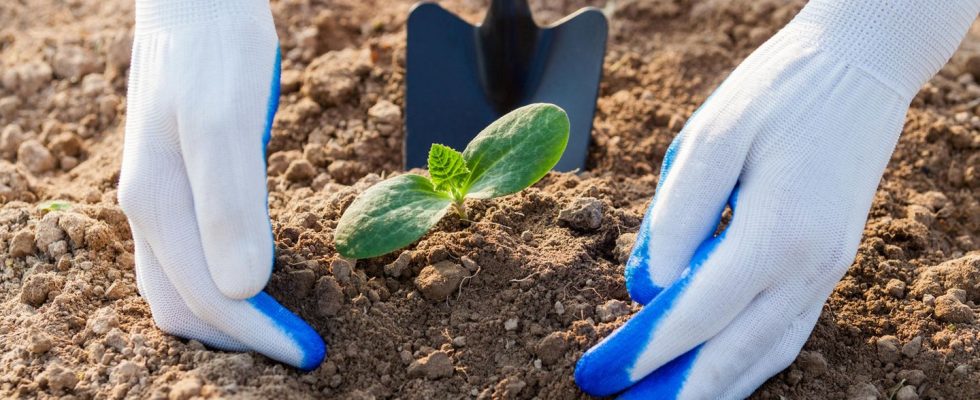protective measure
More than just clean fingers: Why gloves are useful for gardening
Gardening gloves offer more protection against injuries, insects and chemicals
© rootstocks / Getty Images
When the early bloomers poke their heads out of the ground, many a hobby gardener’s fingertips are already tingling. Even if it is still too early to repot or sow, initial preparations are being made for the gardening season. What should not be missing are suitable gloves.
Anyone who owns a garden knows about the regular work that has to be done from spring to autumn: trees have to be cut back, leaves have to be collected and the lawn has to be mown. If you grow your own fruit or vegetables, other tasks such as digging, weeding or repotting are on the agenda. No matter what work you do, wearing gardening gloves is recommended. Because they don’t just serve to keep your hands clean. This article explains what other reasons speak for this and what you should consider when purchasing.
These reasons speak for gloves
It is incorrect to say that the sole purpose of gardening gloves is to protect your hands and fingernails from moisture, soil or dirt. In fact, wearing it brings many other benefits:
- Whether you’re pulling weeds or pruning roses, many plants and shrubs are so stubborn that they can damage you when you remove them with your hands injure skin can. Painful stings, cuts or swelling can be avoided by wearing gloves.
- If you don’t wear protection in the garden, fine cracks or cuts on your hands and arms are not uncommon. This allows fungi and bacteria found in soil and plants to penetrate your skin and Infections promote – such as rose gardener’s disease.
- To get ahead of yourself insect bites To protect yourself, wearing gloves can also make sense – after all, there are all sorts of creatures in the garden (wasps and ants, mosquitoes and beetles) that can sting and bite. Ideally, you should wear long gloves to protect your arms.
- Last but not least, you can prepare your skin Chemicals (and associated skin irritations, rashes or allergic reactions) when you wear gloves. These can be found in herbicides and synthetic fertilizers that are permitted for private use.
These gloves are suitable for the garden
1. Gardening gloves with Mobile Touch
The Planting and soil gloves from Gardena are made of a flexible material that is stretchy at the waistband and back of the hand. A so-called nitrile coating on the inner surface is intended to protect your hands from moisture. In addition, the gardening gloves have a touch function on the thumb and index finger so that you can use your smartphone. The model is from S until XL available. There is also a Child size.
2. Rose gloves
As the name correctly suggests, these should extra long gardening gloves Made of soft artificial leather, they protect your hands and arms from sharp thorns – for example when you have to cut back your roses or do other gardening work that can result in painful cuts. An ideal fit should be possible via an adjustable cuff. The thorn-proof model is available in five sizes (XS to XL).
3. Waterproof gardening gloves
Ordinary gardening gloves offer a certain level of protection from moisture, but are not waterproof – other than that this model: Available in four sizes (S to XL), double latex has been used on the palm and fingers to keep hands and fingers dry for as long as possible. It is important to know that only waterproof gloves like this These ones can permanently protect against moisture.
4. Shrub care gloves
This Gardening gloves from Gardena (available in two sizes) are particularly suitable for cutting work and working with thorny bushes or plants. The inner surfaces between the thumb and index finger have been additionally reinforced. This Oeko-Tex certified model also has a mobile touch function for smartphone use. The long shaft protects the wrists and the base of the forearm.
5. Lined gardening gloves
On cold autumn and winter days, lined thermal gloves offer more comfort and protection for your hands when doing outdoor gardening work – such as this model Made from recycled polyester, with warm fleece and a non-slip rubber coating made from Sandy Latex. It is available in four sizes (S to XL) and, according to the manufacturer, tested according to Oeko-Tex Standard 100.
Buying gardening gloves: This is what you need to keep in mind
Depending on the type of material, gardening gloves have different properties: While cotton is lighter and allows the skin to breathe better, leather offers greater protection. Synthetic materials such as nylon, latex or polyester, on the other hand, are water-repellent but have a shorter lifespan.
When it comes to fit, you should pay attention to the size when buying – if it’s one size fits all, people with small hands are often at a disadvantage. For greater grip, it is advisable to choose gloves that have an anti-slip coating on the inner surfaces or on the fingertips.
Whether gardening gloves can be cleaned in the washing machine depends on the material used. For example, while cotton is easy to wash, this is not the case with leather. Think in advance about which points are most important to you and which properties the gloves should have.
You might also be interested in:
This article contains so-called affiliate links. Further information are available here.


